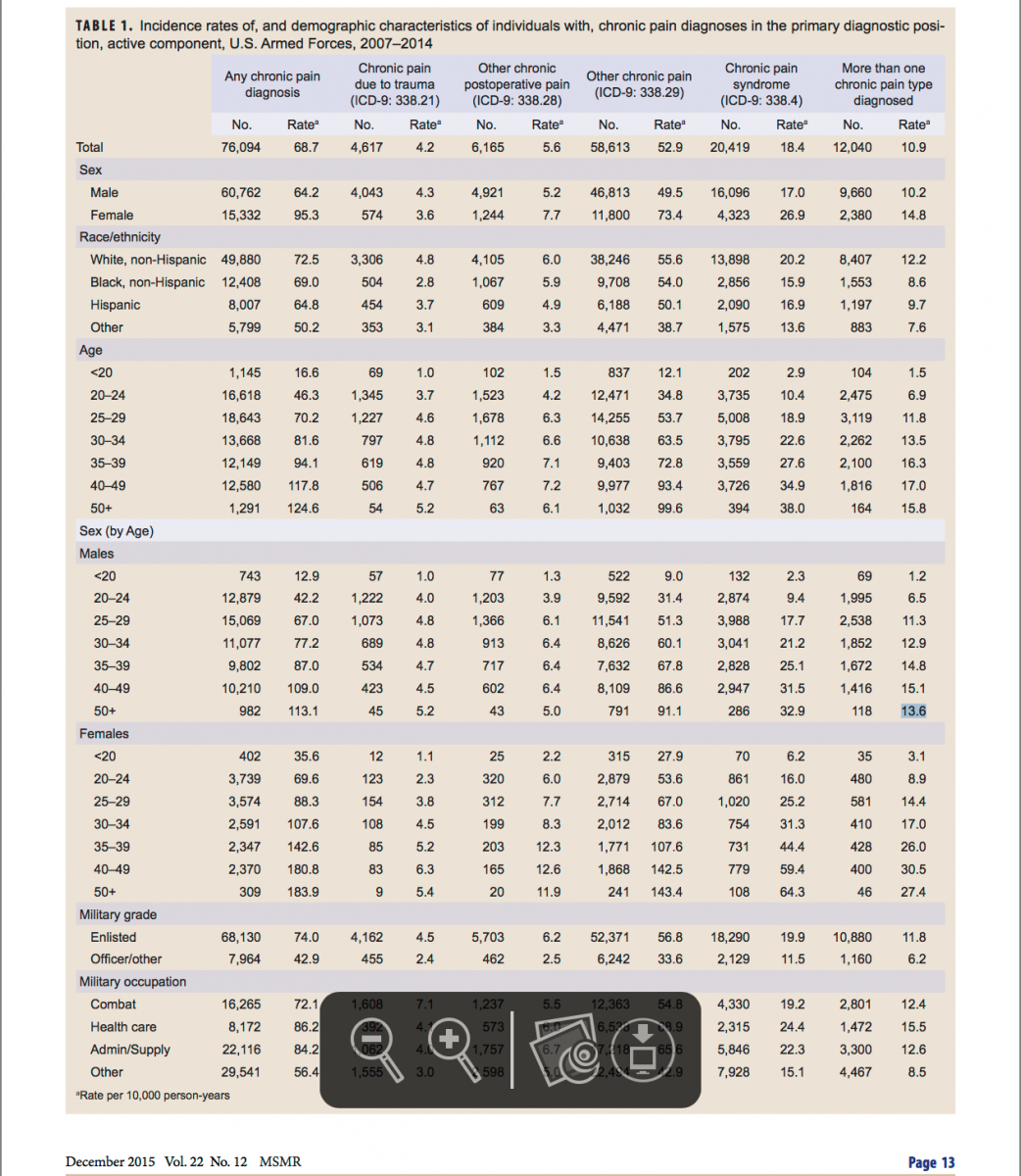By the Numbers - Jan. 11, 2016
30.4 per 10,000
and
107.8 per 10,000
The rate of “any chronic pain diagnosis” in 2007 and in 2014 "per 10,000 person-years" (p-yrs) among "all individuals serving at any time in the active component of the U.S. Army, Navy, Air Force, or Marine Corps between 1 January 2007 and 31 December 2014," according to a report in the December 2015 issue of the Medical Surveillance Monthly Report, published by the Armed Forces Health Surveillance Branch of the Defense Health Agency.
The article -- Incidence of Diagnoses Using ICD-9 Codes Specifying Chronic Pain (not Neoplasm Related) in the Primary Diagnostic Position, Active Component, U.S. Armed Forces, 2007–2014 -- points out that in FY 2007, "multiple new ICD-9 codes related to pain were approved for use." These codes are:
- Chronic pain due to trauma (ICD-9: 338.21)
- Other chronic postoperative pain (ICD-9: 338.28)
- Other chronic pain (ICD-9: 338.29)
- Chronic pain syndrome (ICD-9: 338.4)
According to the article, the overall jump in "incidence rate" of chronic pain diagnoses "was largely driven by increases in incident diagnoses of “other chronic pain,” which increased from 16.2 incident diagnoses per 10,000 p-yrs in 2007 to 90.3 incident diagnoses per 10,000 p-yrs in 2014."
This report documents a striking increase in the numbers and rates of incident medical encounters with a primary diagnosis related to chronic pain during the 8-year surveillance period. This finding is not entirely unexpected given that new codes allowing for greater specificity of pain diagnoses were introduced just prior to the start of the surveillance period; examinations of the utilization of other newly introduced ICD-9 codes have demonstrated a similar upward trend in use.
For all specific chronic pain diagnoses except “chronic pain due to trauma,” females had higher incidence rates during the surveillance period. Except for the category of “other chronic postoperative pain,” incidence rates increased linearly with increasing age, although stratification by gender and age group demonstrated some departures from this general trend.
The researchers note that a 2011 Institute of Medicine report "estimated that chronic pain affects approximately 100 million Americans, and that the prevalence of chronic pain is increasing in the civilian U.S. population."
30.4 per 10,000
and
107.8 per 10,000
The rate of “any chronic pain diagnosis” in 2007 and in 2014 "per 10,000 person-years" (p-yrs) among "all individuals serving at any time in the active component of the U.S. Army, Navy, Air Force, or Marine Corps between 1 January 2007 and 31 December 2014," according to a report in the December 2015 issue of the Medical Surveillance Monthly Report, published by the Armed Forces Health Surveillance Branch of the Defense Health Agency.
The article -- Incidence of Diagnoses Using ICD-9 Codes Specifying Chronic Pain (not Neoplasm Related) in the Primary Diagnostic Position, Active Component, U.S. Armed Forces, 2007–2014 -- points out that in FY 2007, "multiple new ICD-9 codes related to pain were approved for use." These codes are:
- Chronic pain due to trauma (ICD-9: 338.21)
- Other chronic postoperative pain (ICD-9: 338.28)
- Other chronic pain (ICD-9: 338.29)
- Chronic pain syndrome (ICD-9: 338.4)
According to the article, the overall jump in "incidence rate" of chronic pain diagnoses "was largely driven by increases in incident diagnoses of “other chronic pain,” which increased from 16.2 incident diagnoses per 10,000 p-yrs in 2007 to 90.3 incident diagnoses per 10,000 p-yrs in 2014."
This report documents a striking increase in the numbers and rates of incident medical encounters with a primary diagnosis related to chronic pain during the 8-year surveillance period. This finding is not entirely unexpected given that new codes allowing for greater specificity of pain diagnoses were introduced just prior to the start of the surveillance period; examinations of the utilization of other newly introduced ICD-9 codes have demonstrated a similar upward trend in use.
For all specific chronic pain diagnoses except “chronic pain due to trauma,” females had higher incidence rates during the surveillance period. Except for the category of “other chronic postoperative pain,” incidence rates increased linearly with increasing age, although stratification by gender and age group demonstrated some departures from this general trend.
The researchers note that a 2011 Institute of Medicine report "estimated that chronic pain affects approximately 100 million Americans, and that the prevalence of chronic pain is increasing in the civilian U.S. population."


